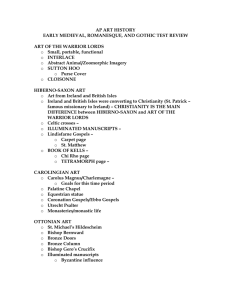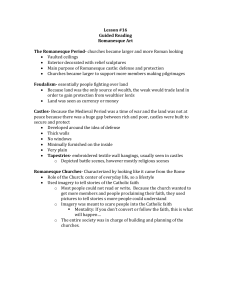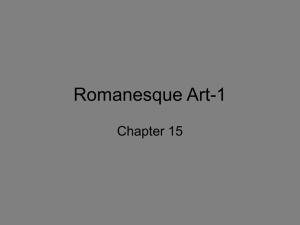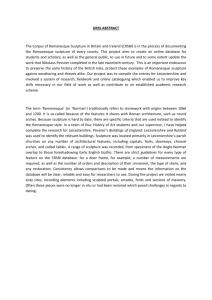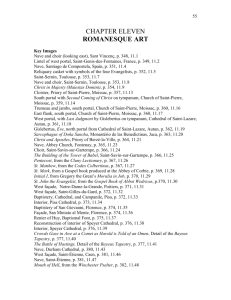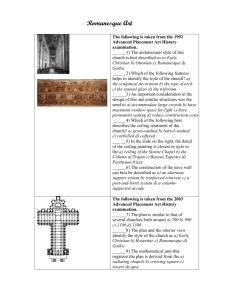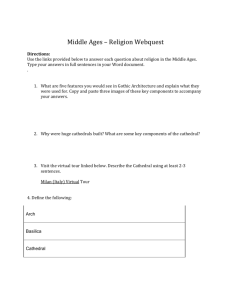routes immense
advertisement
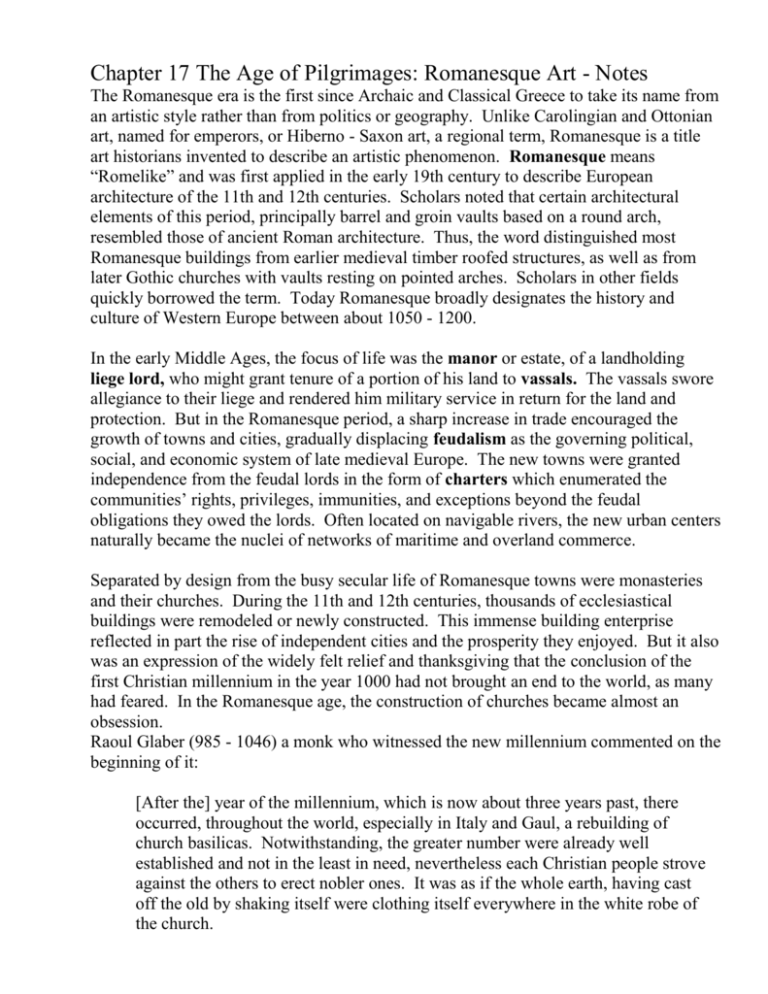
Chapter 17 The Age of Pilgrimages: Romanesque Art - Notes The Romanesque era is the first since Archaic and Classical Greece to take its name from an artistic style rather than from politics or geography. Unlike Carolingian and Ottonian art, named for emperors, or Hiberno - Saxon art, a regional term, Romanesque is a title art historians invented to describe an artistic phenomenon. Romanesque means “Romelike” and was first applied in the early 19th century to describe European architecture of the 11th and 12th centuries. Scholars noted that certain architectural elements of this period, principally barrel and groin vaults based on a round arch, resembled those of ancient Roman architecture. Thus, the word distinguished most Romanesque buildings from earlier medieval timber roofed structures, as well as from later Gothic churches with vaults resting on pointed arches. Scholars in other fields quickly borrowed the term. Today Romanesque broadly designates the history and culture of Western Europe between about 1050 - 1200. In the early Middle Ages, the focus of life was the manor or estate, of a landholding liege lord, who might grant tenure of a portion of his land to vassals. The vassals swore allegiance to their liege and rendered him military service in return for the land and protection. But in the Romanesque period, a sharp increase in trade encouraged the growth of towns and cities, gradually displacing feudalism as the governing political, social, and economic system of late medieval Europe. The new towns were granted independence from the feudal lords in the form of charters which enumerated the communities’ rights, privileges, immunities, and exceptions beyond the feudal obligations they owed the lords. Often located on navigable rivers, the new urban centers naturally became the nuclei of networks of maritime and overland commerce. Separated by design from the busy secular life of Romanesque towns were monasteries and their churches. During the 11th and 12th centuries, thousands of ecclesiastical buildings were remodeled or newly constructed. This immense building enterprise reflected in part the rise of independent cities and the prosperity they enjoyed. But it also was an expression of the widely felt relief and thanksgiving that the conclusion of the first Christian millennium in the year 1000 had not brought an end to the world, as many had feared. In the Romanesque age, the construction of churches became almost an obsession. Raoul Glaber (985 - 1046) a monk who witnessed the new millennium commented on the beginning of it: [After the] year of the millennium, which is now about three years past, there occurred, throughout the world, especially in Italy and Gaul, a rebuilding of church basilicas. Notwithstanding, the greater number were already well established and not in the least in need, nevertheless each Christian people strove against the others to erect nobler ones. It was as if the whole earth, having cast off the old by shaking itself were clothing itself everywhere in the white robe of the church. Pilgrimages The enormous investment in ecclesiastical buildings and furnishings also reflected a significant increase in pilgrimage traffic in Romanesque Europe. Pilgrimages were a very obvious feature of public devotion, proclaiming the pilgrim’s faith in the power of saints and hope for special favor. The journeys often took a year or more to complete. They were undertaken as an act of repentance or as a last resort in their search for a cure for some physical disability. Hardship and austerity were means of increasing the pilgrim’s chances for remission of sin or of disease. The distance and peril of the pilgrimage were measures of the pilgrim’s sincerity of repentance or of the reward they sought. The hordes of pilgrims paying homage to the saints placed a great burden on the churches that stored their relics, but they also provided significant revenues, making possible the erection of even grander and more luxurious structures. The popularity of pilgrimages led to changes in church design, necessitating longer and wider naves and aisles, transepts and ambulatories with additional chapels and second story galleries. The clergy of the various monasteries vied with one another to provide magnificent settings for the display of their relics. They justified the heavy investments to attract donations from places in the Bible such as Psalm 26.8 “Lord I have loved the beauty of your house and the place where your glory dwells.” Traveling pilgrims fostered growth of towns as well as monasteries. Pilgrims were in fact, the primary economic and conceptual catalyst for the art and architecture of the Romanesque period. The pilgrim traffic also established the routes that later became the major avenues of European commerce and communication. Architecture Although the wide spread use of stone vaults in the 11th and 12th century churches inspired the term Romanesque, Romanesque architecture was highly varied and not always vaulted. Some Romanesque churches, especially in Italy, retained wooden roofs long after stone vaulting became commonplace elsewhere. Despite pronounced regional differences, almost all Romanesque buildings manifested a new widely shared method of architectural thinking, a new logic of design and construction. France The church of Saint Etienne (Saint Stephen) at Vignory, France exemplifies the northern style of French Romanesque architecture in which builders used large sawn blocks of stone to construct the walls of the buildings but roofed them with timber. The interior reveals the influence of the three story wood roofed churches of the Ottonian era. The second story is not a true tribune (upper gallery over the aisle opening onto the nave) but rather a screen with alternating piers and columns opening onto very tall flanking aisles. The east end of the church, in contrast has an innovative and influential plan with an ambulatory around the choir and three semicircular chapels opening onto it. These radiating chapels probably housed the churches’ relics, which the faithful could view without having to enter the choir where the main altar was situated. Saint Etienne is an early example of the introduction of stone sculpture into the architecture, which was one of the periods defining characteristics. Here they are confined to relief decoration of the capitals of the ambulatory and false tribunes. Vaulting Further south in southern France, Spain, and Lombardy, early Romanesque builders generally preferred to build with brick or small bricklike blocks of stone and to cover the nave aisles with vaults. The church of Saint Philibert in Tournus, France is an example of this style. Originally the church had a fire prone timber roof that was replaced by masonry vaults around 1060. In the nave cylindrical piers support barrel vaults that run perpendicular to the nave’s axis, one in each bay separated by transverse arches. This scheme made possible the opening of clerestory windows at the ends of the vaults, providing ample lighting to the nave. The aisles were almost as tall as the nave and they are covered by groin vaults that help to buttress the barrel vaults. Saint Sernin Around 1070 the counts of Toulouse began construction of a great new church in honor of the city’s first bishop, Saint Saturninus (San Sernin in French), who was martyred in the middle of the third century. Toulouse was an important stop on the pilgrimage road through southwest France to Santiago de Compostela in Spain where the relics of Saint James were deposited since their discovery in the 9th century. Saint Sernin was designed to accommodate the masses of pilgrims. Sernin’s builder’s created additional space by increasing the length of the nave, doubling the side aisles, and added a transept, ambulatory, and radiating chapels. The radiating chapels opening to the ambulatory and transepts were designed to handle the many pilgrims who had journeyed from afar to view the churches relics. Saint Sernin placed tribunes over the inner aisle that opens to the nave to handle the overflow crowds on special occasions. The tribunes also played an important role in buttressing the continuous semicircular cut stone barrel vaulting that covers the nave. Groin vaults in the tribunes as well as the ground floor aisles absorbed the pressure exerted by the barrel vault running the entire length of the nave. The groin vaults served as buttresses for the barrel vault and transferred the main thrust to the thick outer walls. The interior shows a geometric floor plan that is fully reflected in the nave walls, where piers marking the corner of bays are embellished with engaged half columns. Architectural historians refer to piers with columns or pilasters attached to their rectangular cores as compound piers. Engaged columns rise from the bottom of the compound piers to the vaults springing (the lowest stone of an arch) and continue across the nave as transverse arches. Saint Sernin’s nave seems to be composed of numerous identical vertical volumes of space placed one behind the other as if marching down the buildings length. This rationally integrated scheme, with repeated units decorated and separated by moldings, had a long future in later church architecture in the West. Germany and Lombardy Continuous barrel vaults provided excellent acoustics for church services and were relatively fireproof. But they failed in one critical requirement - lighting. Due to the great outward thrust the barrel vaults exerted along there full length, even when pointed instead of semicircular, a clerestory was difficult to construct. A more complex and efficient type of vaulting was needed. Structurally, the central problem of Romanesque architecture was the need to develop a masonry vault system that admitted light and was also aesthetically pleasing. Covering the nave with groin vaults instead of barrel vaults became the solution. Ancient Roman builders had used the groin vault widely, because they realized that its concentration of thrusts at four supporting points permitted clerestory windows. The great Roman vaults were made possible by the use of concrete, which could be poured into forms, where it solidified into a homogenous mass. But the technique of mixing concrete, had not survived into the Middle Ages. The technical problems of building groin vaults of cut stone and heavy rubble, which had very little cohesive quality, at first limited their use to covering small areas, such as individual bays of the aisles at Saint Sernin. But during the 11th century, masons using ashlar blocks joined with mortar, developed a groin vault of monumental dimensions. The Speyer Cathedral Speyer Cathedral in the German Rhineland is an early example of groin vaults used over a nave. The church was begun in 1030 and was the burial place of the Holy Roman Emperors until the beginning of the 12th century. The original timber roof was replaced between 1082 and 1106 when emperor Henry the IV rebuilt it. His masons covered the nave with groin vaults making possible the insertion of a small clerestory window above each pair of tribune arches. Scholars argue over which region developed this comprehensive use of groin vaulting and when it began. Speyer Cathedral represents one of the most daring and successful engineering experiments at the time. The nave is 45 feet wide and the crowns of the vaults are 107 feet high. Lombard Innovation The church of Saint Ambrogio of Milan was erected in honor of Saint Ambrose, Milan’s first bishop. It is unclear when it was erected, but it was in the late 11th to early 12th century. It is a remarkable building. It is an atrium in the early Christian tradition, a two story narthex pierced by arches on both levels, two bell towers joined to the building, and over the nave’s east end, an octagonal tower that recalls the crossing towers of German churches. Saint Ambrogio has a nave and two aisles, but no transept. Each bay consists of a full square in the nave flanked by two small squares on each aisle, all covered with groin vaults. The main vaults are slightly domical, rising higher than the transverse arches. An octagonal dome covers the last bay, its windows providing most the light for the dark interior. The building lacks a clerestory. The heaviest piers support the main vaults which have supporting arches called ribs. This is one of the first instances of rib vaulting, a salient characteristic of mature Romanesque and later Gothic. Normandy and England After their conversion to Christianity in the early 10th century, the Vikings settled on the Northern coast of France in a place called Normandy. They were skilled administrators and builders, active in Sicily as well as Northern Europe. The Normans developed a distinctive Romanesque style that became a major source of French Gothic architecture. Most critics consider the abbey church of Saint Etienne at Caen the masterpiece of Norman Romanesque architecture. It was begun by William the Conqueror in 1067 and was built rapidly as he was buried there in 1087. Saint Etienne’s west facade has four buttresses that divide the facade into three bays that correspond to the nave and aisles. Above the buttresses, the towers also display a triple division and a progressively greater piercing of their walls from lower to the upper stages. (The culminating spires are a Gothic addition.) The original design of Saint Etienne called for a wooden roof. The nave was built with compound piers with simple engaged half columns alternating with piers with half columns attached to pilasters. When groin vaults were introduced around 1115, the varied nave piers proved an ideal match. The alternating compound piers soar all the way to the vaults springing. Their branching ribs divide the large square vault compartments into six sections, making a six-partite vault. These vaults rise high enough to provide room for an efficient clerestory The resulting three story elevation, with its enlarged arched openings, provides more light to the interior. The diagonal and transverse ribs compose a structural skeleton that partially supports the still fairly massive paneling between them. But despite the heavy masonry, the large windows and reduced interior wall surface give Saint Etienne’s nave a light and airy quality that is unusual in the Romanesque period. English Romanesque William the Conqueror’s conquest of Anglo Saxon England in 1066 began a new epoch in English history. It signaled the importation of French Romanesque building and design techniques. Durham Cathedral sits on a cliff overlooking the Wear River in Northern England. It was begun around 1093 a generation after the Norman conquest. It is the centerpiece of a monastery, cathedral and a fortified castle complex on the Scottish frontier. The Durham Cathedral was conceived as a vaulted structure from the beginning. Consequently, the pattern of the ribs of the nave’s groin vaults is reflected in the design of the arcade below. Each seven part nave vault covers two bays. Large, simple pillars ornamented with abstract designs alternate with compound piers that carry the transverse arches of the vaults. Expert masons had to transform rough stone blocks into the precise shapes necessary for their specific shape in the design. Thousands of simple quadrangular ashlar blocks made up the great walls of the building. More complex shapes in great numbers had to also be cut. Concave blocks for the vaults in the nave and convex for the pillars. It was an immense undertaking and one of the reasons it often took decades to build these structures. Durham Cathedral is the earliest example of a ribbed groin vault over a three story nave. And in the nave’s western parts, completed before 1130, rib vaults were combined with slightly pointed arches, bringing together for the first time two key elements that determined the structural evolution of Gothic architecture. Also of great significance is the way the nave vaults were buttressed. Our lateral section reveals the simple quadrant arches (arches whose curve extends for one quarter of a circle’s circumference) were used in place of groin vaults in the tribune. The structural descendants of the Durham quadrant arches are the flying buttresses that epitomize the mature Gothic solution to church construction. Tuscany The buildings in Tuscany, along with those of Rome itself, adhered closely to the traditions of the early Christian basilica. They underscore that diversity is the rule, not the exception, in Romanesque Europe. Pisa The Cathedral complex at Pisa dramatically testifies to the prosperity this maritime city enjoyed. The complex consists of the cathedral, free standing bell tower, and the baptistery, where infants and converts were initiated into the Christian community. Save for the upper portion of the baptistery, with its remodeled Gothic exterior, the three structures are stylistically homogeneous. Construction of the Pisa Cathedral began first - in 1063, the same year work began on St. Mark’s in Venice. The Pisa project was funded by the spoils of a navel victory over the Muslims off Palermo, Sicily in 1062. The cathedral is large, with a nave and four aisles, and is one of the most impressive and majestic of all Romanesque churches. The Pisians according to a document of the time, wanted their bishop’s church not only to be a monument to the glory of God but also to bring credit to the city. Initially, Pisa Cathedral resembles an Early Christian basilica. But the broadly projecting transept, the crossing dome, and the facades multiple arcaded galleries distinguish it as Romanesque. So to does the marble incrustation (wall decoration consisting of bright panels of different colors.) The cathedral’s campanile (a bell tower of a church, usually, but not always freestanding), detached in the standard Italian fashion, is the famous Leaning Tower of Pisa. The tilted vertical axis is the result of a settling foundation. It began to lean even while under construction and now inclines some 21 feet out of plumb at the top. Graceful arcaded galleries mark the tower’s stages and repeat the cathedral’s motif, effectively relating the round campanile to its mother building. Florence Florence was an important city state in the Romanesque period. The gem of Romanesque architecture in the city is the Baptistery of San Giovanni. Dedicated to Saint John, the city’s patron saint, by Pope Nicholas II in 1059, it was constructed during the succeeding century. Florence’s baptistery faces the city’s great cathedral. The free standing baptisteries of Piza and Florence are unusual and reflect the great importance they placed on baptisms. On the day of a newborn child’s anointment, the citizenry gathered in the baptistery to welcome the new member into their community. The most renowned artists of the Middle Ages and the Renaissance were employed to provide the doors, pulpits, and mosaics for the baptistries. San Giovanni’s simple and classic design recalls Roman architecture. It is a central plan structure like San Vitale and Santa Costanza. The marble incrustations are from Roman wall designs. The exterior is wrapped by an elegant arcade with three arches to a bay. The domical vault is 90 feet in diameter. Sculpture Stone sculpture, with some exceptions, such as the great crosses of the British Isles, had almost disappeared from the art of Western Europe during the Middle Ages. The revival of stonecarving is one of the hallmarks of the Romanesque age - and one of the reasons the period was aptly named. The inspiration for the stone sculpture no doubt came, at least in part, from the abundant remains of ancient statues and reliefs from Rome’s northwestern provinces. Romanesque sculpture motifs and compositions often originated in Carolingian and Ottonian art. But Roman sculpture throughout Europe powerfully influenced the imaginations of Romanesque artists and patrons. Cloister Sculpture The beginnings of revived stone sculpture can be seen in the carved capitals of Saint Etienne at Vignory. The most extensive preserved ensemble of sculpted Romanesque capitals is found in the cloister of Saint Pierre at Moissac in southwestern France. The Moissac abbey was an important stop along the pilgrimage route. The monks enriched by the gifts of the pilgrims and noble benefactors, adorned their church with an elaborate series of relief sculptures. Cloister is an enclosed place. It connotes being shut away from the world. Architecturally, the medieval church cloister expressed the seclusion of the spiritual life the vita contemplativa. The cloister provided the monks and nuns with a taste of paradise. Its garden or timber roofed walkway supported by piers and columns that framed the garden, they could read their devotions, pray, and meditate in an atmosphere of calm serenity, where one could commune only with God. The 12th century cloisters are monuments to the vitality and popularity of monasticism at its peak. Moissac’s cloister sculpture program consists of large figural reliefs on the piers as well as historiated (ornamented with figures) capitals on the columns. The pier reliefs portray the 12 apostles and the first Cluniac abbot of Moissac, Durandus (1047 - 1072), who was buried in the cloister. The 76 capitals alternately crown single and paired column shafts. They are variously decorated, some with abstract patterns, many with Biblical scenes or the lives of saints, others with fantastic monsters of all sorts - basilisks, griffins, lizards, gargoyles, and more. Such bestiaries became very popular in the Romanesque age. The monstrous forms were reminders of the chaos and deformity of a world without God’s order. Art and the Laity The Romanesque period also witnessed the spread of sculpture to other areas of the church, inside and out. Art historians have noted the reemergence of monumental stone sculpture in Western Europe coincided with the introduction of stone vaulting in Romanesque churches. Why this is, is not known with surety. Stone carving is, however, consistent with the widespread desire in the Romanesque period to beautify the House of the Lord. The proliferation of stone sculpture in the 12th century also reflects the changing role of many churches in Western Christendom. In the Early Middle Ages, most churches served small monastic communities, and the worshipers where primarily clergy. With the rise of towns in the Romanesque period, churches, especially those on the major pilgrimage routes, increasingly served the lay public. To reach this new, largely illiterate audience and to draw a wider population into their places of worship, church officials decided to display Christian symbols and stories throughout their churches, especially in portals. Stone, rather than painting or mosaic, was the most suitable durable medium for such exterior decorative programs. Sculpture at Toulouse One of the earliest precisely dated large Romanesque figure reliefs is a group of seven marble slabs, representing angels, apostles, and Christ, made for the great pilgrimage church of Saint - Sernin at Toulouse. An inscription states that the reliefs date to the year 1096 and the artist was a certain Bernardus Gelduinus. Today the plaques are attached to the ambulatory walls, undoubtedly not the original location. The centerpiece of the group is the figure of Christ in Majesty. Christ sits in a mandorla, his right hand raised in blessing, his left hand rests on an open book with the words Pax Vobis (“peace be unto you”). The signs of the Four Evangelists, occupy the corners of the slab. The source of Gelduinus’ style is debated but could be from a Carolingian or Ottonian work. Genesis at Modena Some 15 years later, around 1110, another sculptor carved one of the first fully developed narrative reliefs in Romanesque art. The facade of Modena Cathedral in northern Italy has a marble frieze that extends on two levels across three of its bays. It represents scenes from Genesis set against an architectural backdrop of a type common on Late Roman or Early Christian sarcophagi, which were plentiful in the area. The segment shown depicts the creation and temptation of Adam and Eve. The faithful who entered the house of the Lord would see this depiction and it would remind them of Original Sin and that he only path of salvation is through the Christian church. The relief carving is high and some parts almost entirely round. The name of the master craftsman who made this was Wiligelmo whose name is on an inscription on another relief. There he boasts, “Among sculptors, your work shines forth, Wiligelmo.” The inscription also is an indication of the pride of Wiligelmo’s patrons had in obtaining the services of such an accomplished sculptor for their city’s cathedral. The Second Coming While the Modena frieze recounts mans beginnings, some 25 years later, the south portal of Saint Pierre at Moissac, facing the town square, announced man’s end. The portal’s vast tympanum (the prominent semicircular lunette above the doorway proper) depicts the Second Coming of Christ as King and Judge of the World in it’s last days. As befits his majesty, the enthroned Christ is at the center, following compositional protocol since Early Christian times. The signs of the Four Evangelists flank him. To one side of each pair of signs is an attendant angel holding scrolls to record human deeds for judgment. The figures of crowned musicians, which complete the design, are the Twenty-Four Elders who accompany Christ as the Kings of this world and make music in his praise. Each turns to face him. The two courses of wavy lines symbolizing the clouds of heaven divide the Elders into three tiers. Many variations in style exist in Romanesque sculpture and architecture. The extremely elongated bodies of the recording angels, the cross legged dancing pose of Saint Matthew’s angel, and the jerky, hinged movement of the Elder’s heads are characteristic of the nameless sculptor’s style of representing the human figure. The zigzag and dovetail lines of the draperies, the band-like folds of the torsos, the bending back of the hands against the body, and the wide cheek bones are common features of this distinctive style. The animation of the individual figures, however, contrasts with the stately monumentality of the composition as a whole, producing a dynamic tension in the tympanum. Below the tympanum are a richly decorated trumeau and elaborate door jambs with scalloped contours. The scalloped contours are borrowed from Islamic architecture. On the trumeau’s right face is a prophet, whom some identify as Jeremiah, others as Isaiah. He displays a scroll where his prophetic vision is written. His position below the apparition of Christ as the apocalyptic Judge is yet another instance of the pairing of Old and New Testament themes, as was done since Early Christian times. The prophets figure is very tall and thin, in the manner of the tympanum angels, and like Matthew’s angel executes a cross legged step. The animated body reveals the passionate nature of the soul within. Six roaring interlaced lions fill the Trumeau’s outer face. The idea of placing fearsome images on the gateways to important places is an ancient practice. Judgment at Autun In 1132, Bishop Etienne de Bage consecrated the Burgundian cathedral of Saint Lazare (Saint Lazarus) at Autun. For its Tympanum he commissioned a dramatic vision of the Last Judgment, announced by four trumpet - blowing angels. In the center, far larger than any other figure, is Christ enthroned in a mandorla. He dispassionately presides over the separation of the Blessed from the Damned. At the left an obliging angel boosts one of the blessed into the heavenly city, below the souls of the dead line up to await their faith. Two of the men near the center of the lintel carry bags emblazoned with a cross and a shell. These are the symbols of pilgrims to Jerusalem and Santiago de Compostela. Those who made the difficult journey would be judged favorably. To their right, three small figures beg an angel to intercede on their behalf. The angel responds by pointing to the judge above. On the right half are those who would be condemned to Hell. One poor soul is plucked from the earth by giant hands. Directly above, in the tympanum, is one of the most unforgettable renditions of the weighing of souls in the history of art. Angels and devils contest at the scales, each trying to manipulate the balance for or against a soul. Hideous demons roar. Their gaunt, lined bodies, with legs ending in sharp claws, writhe and bend like long, loathsome insects. A devil leaning from the dragon mouth of Hell drags souls in, while above him, a howling demon crams souls head first into a furnace. The resources of the Romanesque imagination, heated by a fearful faith, conjured up an appalling scene. One can appreciate the terror the Autun tympanum must have inspired in the believers who passed beneath it as they entered the cathedral. Even those who could not read could “read in the marble.” For those who could read, a message was engraved, in Latin, under the tympanum. It warned, in describing the Last Judgment scene above, “May this terror terrify those whom earthly terror binds, for the horror of these images here in this manner truly depicts what will be.” A second prominent inscription beneath the feet of Christ names Gislebertus as the sculptor. Some have suggested this was done as a prayer request for his on salvation on Judgment day. Pride was nonetheless an important factor in the increasing number of artist’s signatures in Romanesque times. Painting Unlike the practices of placing vaults over naves and aisles and decorating building facades with monumental stone reliefs, the art of painting did not need to be revived in the Romanesque period. Illuminated manuscripts had been produced in large numbers in the early Middle Ages, and Roman mural painting never died. But the quality of preserved frescos and illustrated books from the Romanesque era are unprecedented. As is true of Romanesque architecture and sculpture, painting of this period exhibits considerable stylistic and regional diversity. Mural Painting In the 8th century, Muslim armies from North Africa defeated the Visigoths and occupied almost all of Spain. But in Northern Spain, the Muslims never completely controlled many areas, and Christianity and Christian art still flourished. One of the most impressive frescos, now in the Boston Museum of Fine Arts, once filled the apse of Anta Maria de Mur, a monastery church near Lerida. The formality, symmetry, and placement of the figures are Byzantine. But the Spanish artist rejected Byzantine mosaic in favor of direct painting on plaster covered walls. The iconographic scheme in the semi-dome of the apse is more closely tied to those of French Romanesque church portals. In our fresco, Christ in a star strewn mandorla is flanked by the signs of the four evangelists. The theme is that of the Apocalypse, a theme that fascinated the Romanesque imagination. Seven lamps between Christ and the Evangelists’ signs symbolize the seven Christian communities (churches) that John addressed in the beginning of the book of Revelation. Below stand apostles paired off in frontal formality. The principal figures are rendered with partitioning of drapery in volumes, made tubular in places by local shading. The painter stiffened the irregular shapes of actual cloth into geometric patterns. The effect overall is one of simple, strong, and even blunt directness of statement, reinforced by harsh, bright color, appropriate for a powerful icon. Italy and Byzantium The tradition of decorating church apses with imposing images of Christ and saints dates back to Early Christian art. So to was the idea of illustrating Old and New Testament episodes above the nave in basilican churches. In the 11th century, Romanesque artists used fresco rather than mosaic to create framed scenes from Christ’s life along both sides of the nave of Sant’ Angelo in Formis, near Capua in Southern Italy. Our detail shows the panel illustrating the entombment of Christ. Mary cradles the head of her dead son as Joseph or Arimathea and Nicodemus lower him in the coffin. The weeping Saint John the Evangelist (with nimbus) watches. The figures are fully modeled, the 3D architectural setting, and the natural blue sky provide sharp contrast with the mural from Spain, even though there appears that Byzantine artworks were used as models. Sant’ Angelo was constructed and decorated under the direction of Abbot Desiderius (later Pope Victor III). The monastery of Saint Benedict, also on this site, was built in the 6th century. Desiderius imported artists from Constantinople and instructed them to train his monks in mosaic and other art. Painted Vaults The murals of the Benedictine Abby church of Saint-Savin-sur-Gartempe were inconceivable before mastering of stone vaulting in the Romanesque period. Saint Savin is a hall church (a church where aisles are the same height as the nave). The tall windows in the aisles provided more illumination to the nave than most churches that had low aisles and tribunes. This may explain why paintings (not to frescos) decorate the nave’s continuous barrel vault. The subjects were all taken from the Pentateuch, in contrast to New Testament themes. They also bear little resemblance stylistically to the Byzantine inspired murals, instead they are more like the reliefs of Southern French portals. Bayeux Tapestry The account of Romanesque painting concludes with a work that is not a painting. Nor is the so called Bayeux Tapestry a woven tapestry. It is instead, an embroidered fabric made of wool sewn on linen. Visually it is closely related to manuscript illumination. Its borders are populated by the kinds of real and imaginary animals found in contemporaneous books, and an explanatory Latin text sewn in thread accompanies many of the pictures. Some 20 inches high and about 230 feet long, the Bayeux Tapestry is a continuous, friezelike, pictorial narrative of a crucial moment in England’s history and of the events that led up to it. The Norman defeat of the Anglo-Saxons at Hastings in 1066 brought England under the control of the Normans, uniting all of England and much of France under one rule. The Dukes of Normandy became the kings of England. Commissioned by Bishop Odo, the half brother of the conquering Duke William, the embroidery may have been sewn by women at the Norman court. Many art historians, however, believe it was a work of English stitchers in Kent, where Odo was earl after the Norman Conquest. Odo donated the work to Bayeux Cathedral. It is uncertain whether it was intended for display in the church nave, where its theme would have been an unusual choice. In 1066 Edward the confessor, the Anglo-Saxon king of England died. The Normans believed Edward had recognized William of Normandy as his rightful heir. But the crown went to Harold of Wessex, the king’s Anglo-Saxon brother in law, who had sworn an oath of allegiance to William. The betrayed Normans, descendants of the Vikings, boarded their ships and crossed the English Channel, and crushed Harold's forces. We illustrate three episodes from the tapestry. Our first is an example is a section that depicts the appearing of Haley's Comet, a diurnal view of Haley's Comet among other bright objects in the night sky over the English Channel on successive nights beginning in April 1066. The view is from Normandy as it would have been seen by William the Bastard, Duke of Normandy. William took the comet to be a good omen, and later that year he invaded England. On October 14, 1066 he defeated the Saxon King Harold Godwinson at the battle of Hastings. A representation of the comet appears on the Bayeux Tapestry. It can be seen at the top center of the panel. The Anglo-Saxon Chronicle describes the event: "Easter was then on the sixteenth day before the calends of May. Then was over all England such a token seen as no man ever saw before. Some men said that it was the comet-star, which others denominate the long-haired star. It appeared first on the eve called 'Litania major', that is, on the eighth before the calends of May; and so shone all the week." In our second example the Battle of Hastings is in progress. The Norman cavalry cuts down the English defenders. The lower border is filled with the dead and the wounded, although the upper register continues the animal motifs of the rest of the embroidery. The Romanesque co-opted some of the characteristic motifs of Greco Roman battle scenes. Note the horses with twisted necks and contorted bodies. But the artists rendered the figures in the Romanesque manner. Linear patterning and flat color replaced classical three dimensional volume and modeling in light and dark hues. The Bayeux Tapestry is unique in Romanesque art in that it depicts an event in full detail at a time shortly after it occurred, recalling the historical narratives of ancient Roman art. The Norman embroidery often has been likened to Trajan’s column. Like the Roman account, the story told on the tapestry is the conqueror’s vision of history, a proclamation of national pride. Like Trajan’s column, it is a complete chronicle of events. Included are preparations for war, with scenes of the feeling and splitting of trees to build ships. Loading equipment, cooking and serving meals, and signs in the sky are depicted. Conclusion With a death of the last Ottonian emperor in 1024, the greatest patrons of art and architecture in Europe became the monasteries, especially those on the pilgrimage routes leading to the tomb of Saint James in Spain. In the Romanesque age, immense churches with stone vaults rose throughout Europe, relief sculptures adorned church portals and cloisters, and relics of the saints were housed in gold and and silver and enameled reliquaries (containers for holding the relics of saints). Not everyone embraced new artistic trends. The Cistercians in particular shunned elaborate churches designed to accommodate multitudes of pilgrims, and banned figural adornment in their sacred books. Bernard of Clairvaux, the influential Cistercian abbot who was later beatified, protested as fervently against decoration to monastic churches, as he preached for the Crusades to capture the Holy Land from the Muslims. But for most clergy and laity alike, the appeal of new churches with their sculpted reliefs and glittering relics was irresistible. Each region had a characteristic style, but the revival of monumental architecture and sculpture was Europe wide.
